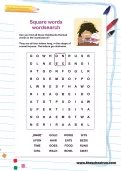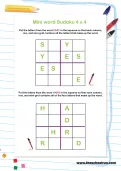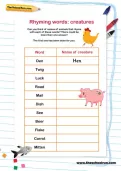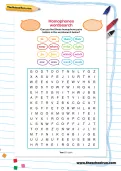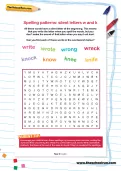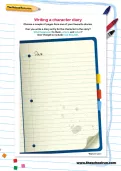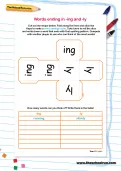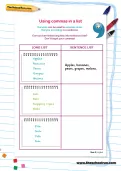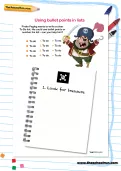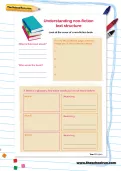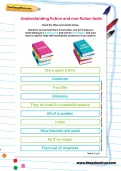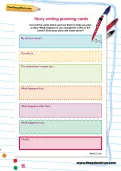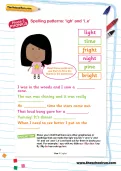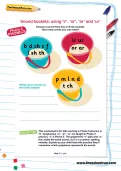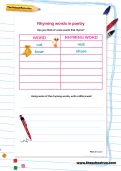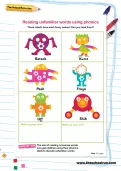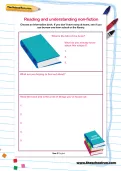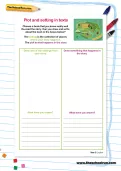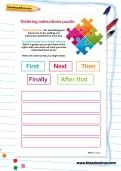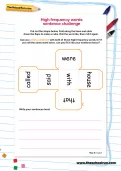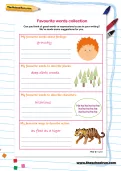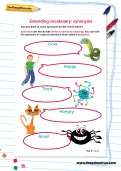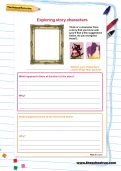Ks1 English worksheets
Free worksheets: Word puzzles, KS1
You’ll need to login or Register first to access these worksheets for free.
Once you’ve tried out our free worksheets, why not explore all our resources (1000s of worksheets, interactive tutorials, learning packs and more) with a 14-day FREE trial subscription.
Square words wordsearch
Can you find all these Goldilocks-themed words in the wordsearch?
Mini word Sudoku 4 x 4
Put the letters from the word EASY in the squares so that each column, row, and mini-grid contains all the letters that make up the word.
Rhyming words: creatures word puzzle
Practise your rhyming and spelling skills by thinking of names of animals that rhyme with each of these words. There could be more than one answer... how many can you identify?
Homophones wordsearch
Can you find these homophone pairs hidden in the wordsearch below?
Spelling patterns: silent letters w and k
A Year 2 English wordsearch created by a teacher, which focuses on the silent letters w and k. Examples and answers are included.
Writing a character diary
Choose a couple of pages from one of your favourite stories. Can you write a diary entry for the character in the story? What happened to them, where and when? Don’t forget to include how they felt.
Words ending in -ing and -ly
Cut out the shape below. Fold along the lines and stick the flaps to make a word endings cube. Take turns to roll the dice and write down a word that ends with that spelling pattern. Compete with another player to see who can think of the most words! How many words can you think of? Write them in the table!
Using commas in a list
Commas can be used to separate items that you are listing in a sentence. Can you turn these long lists into sentence lists? Don’t forget your commas!
Using bullet points in lists
Pirate Pegleg wants to write a clear To Do list. He could use bullet points or number his list – can you help him?
Understanding non-fiction text structure
Look at the cover of a non-fiction book. What is the book about? Turn to the contents page. List four things you’d like to find out about. If there is a glossary, find some words you’ve not heard before.
Understanding fiction and non-fiction texts
Read these titles and words. Cut them out and put them in two piles, one for things you think belong in a fiction book and one for non-fiction. Ask your mum or dad for help with reading the sentences if you need to.
Their or there?
The two different ways of spelling this word are for two different meanings. If you’re talking about the place there it’s THERE. If it’s something belonging to someone (e.g. their house) it’s THEIR. Remember the difference by thinking there has the word 'here' in it. See if you can put the correct spelling of their/ there into these sentences.
Story writing planning cards
Cut out the cards below and use them to help you plan a story. What happens if you change the order of the cards? Does your story still make sense?
Spelling patterns: 'igh' and 'i_e' (Phase 5 phonics)
Read these words and use them to fill in the blanks in the sentences. We are practising spelling words with 'igh' and 'i_e'.
Sound buckets: using ‘ir’, ‘or’, ‘ar’ and ‘ur’ (Phase 5 phonics)
Choose a sound from two or three of the buckets and see how many words you can make.
Rhyming words in poetry
Can you think of some words that rhyme? Write them down here then use some of them to write a little poem!
Reading unfamiliar words using phonics
A KS1 worksheet of nonsense words, based on the National Curriculum and created by a phonics expert to get Year 1 children using their phonics skills to decode unfamiliar words.
These robots have such funny names! Can you read them?
These robots have such funny names! Can you read them?
Reading and understanding non-fiction
Choose an information book. If you don’t have many at home, see if you can borrow one from school or the library. What is the title of the book? What are you hoping to find out about? What do you already know about this subject? Read the book and write a list of things you’ve found out:
Putting names in alphabetical order
Write the name of one of your friends or someone in your family in each box, and draw a portrait of them. Can you cut the boxes out and put portraits in alphabetical order?
Plot and setting in texts
Choose a book that you know really well. Re-read the story. Can you draw and write about the book in the boxes? The setting is the collection of places where your story happens. The plot is what happens in the story. Draw one of the settings from your story and something that happens in your story.
Ordering instructions puzzle
Write instructions for something you know how to do, putting one instruction sentence in each box. Cut out the boxes and muddle them up. See if a grown-up can put them in the right order and work out what you have instructed them to do! Here are some words you might need: first; next; then; finally; after that.
High frequency words sentence challenge
Cut out this shape. Fold along the lines and stick down the flaps to make a cube. Roll the word die, then roll it again. Can you write a sentence with both of those high frequency words in? If you roll the same word twice, can you fit it into your sentence twice? Then write your sentences down.
Favourite words collection
Can you think of great words or expressions to use in your writing? We’ve made some suggestions for you. What are your favourite words about your feelings? What are your favourite words to describe places? What about describing characters or actions?
Extending vocabulary: synonyms
Can you think of some synonyms for these words? Synonyms are words with similar or identical meanings. You can look for synonyms in a special reference book called a thesaurus.
Exploring story characters
Think of a character from a story that you know well (you’ll find a few suggestions here, do you recognise them?). What is your character’s name? Draw their picture! What happens to them at the start of the story? What happens to them at the end of the story?
